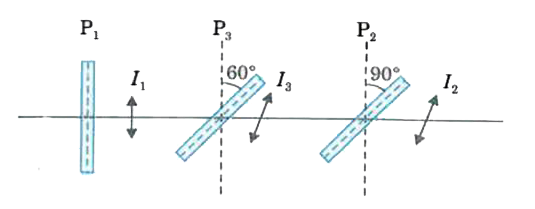Unpolarised light of intensity I0 passes through two polaroids P1andP2 such that pass axis of P1. A third polaroid P3 is placed between P1andP2 with pass axis of P3 making an angle 60∘ with that of P1. Determine the intensities of light transmitted by P1,P2andP3.
Let I1,I2andI3 are the intensities of light after passing through P1,P2andP3 respectively.
I1=I0/2
I3=I1cos260∘=(I02)(14)
⇒I3=I0/8
I2=I3cos230∘=(I08)(34)
⇒I2=3I0/32

Topper's Solved these Questions
- BOOK - MODERN PUBLICATIONCHAPTER - WAVE OPTICALEXERCISE - PRACTICE PROBLEMS (1)23videos
WAVE OPTICAL
- BOOK - MODERN PUBLICATIONCHAPTER - WAVE OPTICALEXERCISE - PRACTICE PROBLEMS (2)10videos
WAVE OPTICAL
- BOOK - MODERN PUBLICATIONCHAPTER - SEMICONDUCTOR ELECTRONICS METERIALS DEVICES AND SIMPLE CIRCUITS EXERCISE - CHAPTER PRACTICE TEST FOR BOARD EXAMINATION12videos
SEMICONDUCTOR ELECTRONICS METERIALS DEVICES AND SIMPLE CIRCUITS
Similar Questions
Unpolarized light is intensity I0 passes through two polaroids P1 and P2 such that pass axis of P2 makes an angle θ with the pass axis of P1. A third polaroid P3 is placed between P1 and P2 with pass axis of P3 making an angle β with that of P1. If I1,I2,I3 represent intensities of light trnasmitted by P1,P2,P3, determine the values of angle θ and β for which I1=I2=I3.
View Solution(a) Using the phenomenon of polarisation, show how transverse nature of light can be demonstrated.
(b) Two polaroids P1andP2 are placed with their pass axes perpendicular to each other. Unpolarised light of intesity I0 is incident on P1. A third polaroid P3 is kept in between P1 and P2 such that its pass axis makes an angle of 30∘ with that of P1. Determine the intensity of light transmitted through P1,P2andP3.View Solution
Knowledge Check
- Question 1 - Select One
Two Polaroids P1 and P2 are placed with their axis perpendicular to each other. Un-polarized light I0 is incident on P1. A third polaroid P3 is kept in between P1 and P2 such that its axis makes an angle 45∘ with that of P1. The intensity of transmitted light through P2 is
AI04BI08CI016DI02
(a) Using the phenomenon of polarisation, show how transverse nature of light can be demonstrated.
(b) Two polaroids P1andP2 are placed with their pass axes perpendicular to each other. Unpolarised light of intensity I0 is incident on P1. a third polaroid P3 is kept in between P1 and P2 such that its pass axis makes an angle of 30∘ with that of P1. determine the intensity of light transmitted through P1,P2andP3.View Solution(a) Using the phenomenon of polarization, show, how, transverse nature of light can be demonstrated.
(b) Two polaroids P1andP2 are placed with their pass axes perpendicular to each other. Unpolarised light of intensity 10 is incident on P1. A third polaroid P3 is kept in between P1andP2 such that its pass axis makes an angle of 30∘ with that of P1. Determine the intensity transmitted through P1,P2andP3.View SolutionExplain, with the help of a diagram, how plane polarised light can be produced by scattering of light from the Sun.
Two polaroids P1andP2 are placed with their pass axes perpendicular to each other. Unpolarised light of intensity I is incident on P1. a third polaroid P3 is kept between P1andP2 such that its pass axis makes an angle of 45∘ with that of P1. calculate the intensity of light transmitted through P1,P2andP3.View SolutionA narrow beam of unpolarised light of intensity I0 is incident on a polaroid P1. The light transmitted by it is then incident on a second polaroid P2 with its pass axis making an angle of 60∘ to the pass axis of P1. Find intensity of light transmitted by P2.
View SolutionA narrow beam of unpolarised light of intensity I0 is incident on a polaroid P1. The light transmitted by it is then incident on a second polaroid P2 with its pass axis making an angle of 60∘ to the pass axis of P1. Find intensity of light transmitted by P2.
View Solution(a) Distinguish between unpolarised light and linearly polarised light. How does one get linearly polarised light with the hel of a polaroid ?
(b) A narrow beam of unpolarised light of intensity I0 is incident on a polaroid P1. The light transmitted by it is then incident on a second polaroid P2 with its pass axis making angle of 60∘ relative to the pass axis of P1. find the intensity of the light transmitted by P2.View Solution(a) Distinguish between unpolarized light and linearly polarized light. How does one get linearly polarised light with the help of a plaroid ?
(b) A narrow beam of unpolarised light of intensity I0 is incident on a polaroid P1. The light transmitted by it is then incident on a second polaroid P2 with its pass axis making angle of 60∘ relative to the pass axis of P1. Find the intensity of the light transmitted by P2.View Solution

